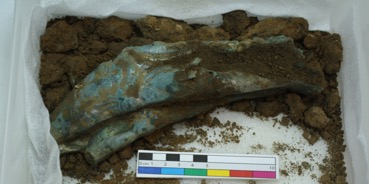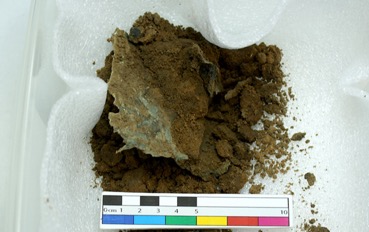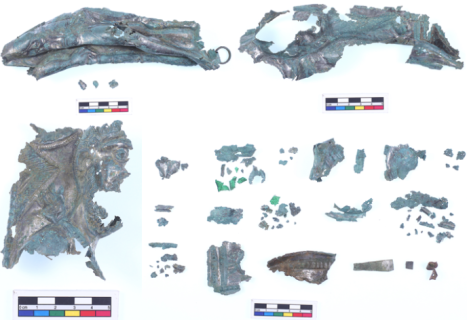 Carla Russo is a first-year MSc student from Argentina. Her background is in Economics and Finance before eventually following her call and getting a degree in Classical Archaeology. She is very interested in cultural heritage and archaeological material, which led to her pursue of the MSc degree in Conservation for Archaeology and Museums at UCL. (Text by Carla Russo)
Carla Russo is a first-year MSc student from Argentina. Her background is in Economics and Finance before eventually following her call and getting a degree in Classical Archaeology. She is very interested in cultural heritage and archaeological material, which led to her pursue of the MSc degree in Conservation for Archaeology and Museums at UCL. (Text by Carla Russo)
In January of 2019 fragments of copper-alloy armour were found via metal detector in southeast Suffolk (figure 1-2). The bronze fragments were reported to the Suffolk County Council Archaeological Service, which carried out an excavation of the site with the finders and retrieved the fragments. Following conservation treatment, the objects will be donated to a public institution of the landowner and finder’s choice.
 Figure 1. Copper-alloy armour fragments found in Suffolk via metal detector (before conservation treatment).
Figure 1. Copper-alloy armour fragments found in Suffolk via metal detector (before conservation treatment).
 Figure 2. Copper-alloy armour fragments found in Suffolk via metal detector (before conservation treatment).
Figure 2. Copper-alloy armour fragments found in Suffolk via metal detector (before conservation treatment).
When they arrived at the conservation laboratory at UCL, the fragments were covered in soil and it was not known how many pieces there were in total (figure 3-5). The fragments were bent and scratched in multiple areas, presumably as they were found unstratified in the plough soil, having been disturbed from their context by agriculture. All the pieces were micro-excavated carefully and documented, as this was a fresh archaeological discovery. The fragments were in need of first aid conservation, meaning that they had to be retrieved from the soil, cleaned and stabilized (figure 6-7).
 Figure 3. Large copper-alloy armour fragment in original soil.
Figure 3. Large copper-alloy armour fragment in original soil.
 Figure 4. Initial digital documentation of large copper-alloy armour fragment in original soil.
Figure 4. Initial digital documentation of large copper-alloy armour fragment in original soil.
 Figure 5. Large copper-alloy armour fragment in original soil.
Figure 5. Large copper-alloy armour fragment in original soil.
There were three large fragments which had depictions of a male torso holding a club, a head and a lion’s face, the combined pieces being a representation of Hercules. It was probably from a highly decorated piece of armour, perhaps part of a chamfron that protected a cavalry horse’s head. This is a very unusual item find in Britain.
 Figure 6. Large copper-alloy armour fragment depicting a male torso with a club after initial cleaning.
Figure 6. Large copper-alloy armour fragment depicting a male torso with a club after initial cleaning.
 Figure 7. Copper-alloy armour fragment depicting a male head during cleaning process.
Figure 7. Copper-alloy armour fragment depicting a male head during cleaning process.
The pieces were cleaned using a variety of tools, including brushes and cotton swabs to ensure all the dirt and corrosion was removed successfully (figure 8).
The object was returned to Suffolk County Council Archaeological Service, where future work on the fragments includes illustration and potentially photogrammetry, to reconstruct the object digitally, and 3D printing of some of the pieces.
 Figure 8. Copper-alloy armour fragments after conservation treatment.
Figure 8. Copper-alloy armour fragments after conservation treatment.
———————————————-